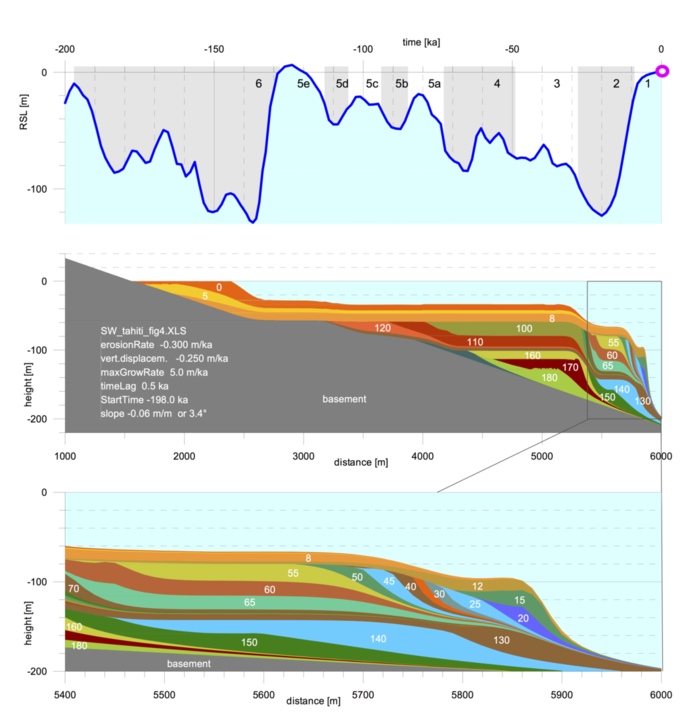- Startseite
- Martin Kölling
- SEALEX reef growth model
SEALEX reef growth model

Figure 1: result of an example run of SEALEX (Koelling et al., 2009) for a Tahiti type reef. Boundary conditions as shown in the inset. Sea level forcing with sea-level curve (above) from Waelbroeck et al. (2002) QSR 21: 295-305. middle: Overall structure of a modeled fossil reef of the Tahiti type. The box indicates the location of the zoomed view. below. Zoomed view of the seaward part without vertical exaggeration. The model run starts at -200ka with a straight slope. The white numbers show the minimum age of the internal reef structure in ka.
During the IODP 310 Tahiti Sea Level Expedition a reef growth model has been developed using an Excel spreadsheet. The forward model is driven by a user definable sea level curve. Other adjustable model parameters include maximum growth rate, the coral growth depth dependance and light attenuation, subaerial erosion and subsidence. During the model run, both, the external shape and the internal chronologic structure of the growing reef are continuously displayed and recorded.
Example of Tahiti type reef model run in Excel 2003 for Windows:
The model has been used to test the effects of different sea level curves on fossil reef systems growing on both, a subsiding island like Tahiti (subsidence rates of 0.25 m ka-1 ) and on uplifting coastal situations like Huon Peninsula ( uplift rates of 0.5 to 4 m ka-1) or Haiti (uplift rates of 0.55 mka-1). The model runs show the sensitivity of the resulting overall morphology and internal age structure to different model parameters. Additionally the water depth at the time of formation is recorded. This allows the constructions of virtual borehole logs, with both, the age profiles and the water depth at the time of coral growth displayed and recorded.
Since the model is implemented as a macro in a popular spreadsheet program, it may be easily adapted or extended to model the growth of different reef and carbonate platform settings. Single model runs take a few minutes to half an hour on a modern Windows desktop or laptop computer
The model may be used to investigate the effects of different boundary conditions such as maximum reef growth, erosion rates subsidence or uplift on both, the general morphology of the reefs, and the internal chronology structure. These results may then be used to compare them to observed data and to test different hypothesis on their genesis.The model may also be used to assist in finding sampling locations in reef bodies that are likely to contain critical information for sea level studies.
The model uses similar ideas as found in ReefGrow a model written by W.Berger in BASIC in the 90ties. A very nice adaption of Wolf Bergers ReefGrow2 original code with additional features may be downloaded as a JAVA applet from the MBARI REEFGROW2 website.
Publication:
Martin Koelling, Jody Webster, Gilbert Camoin, Yasufumi Iryu, Edouard Bard, Claire Seard (2009) SEALEX - Internal reef chronology and virtual drill logs from a spreadsheet-based reef growth model. Global and Planetary Change, 66(1-2). 149-159. doi:10.1016/j.gloplacha.2008.07.011


